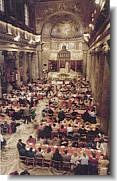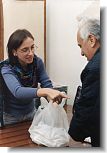|
In all big cities many people, for various reasons, are forced to live on the street.
The members of the Community of Sant'Egidio, following the example of the Good Samaritan in the Gospel parable, stop and try to take care of people who live in these situations of great difficulty; in train stations, in doorways and on street corners etc.
The commitment made by the Community to this world started in Rome towards the end of the 70s when the number of poor on the streets of the city was rising rapidly, posing new problems. It has continued to many other cities all over the world.
Several episodes of intolerance and violence towards these people have made us reflect on the situation of neglect and danger in the lives of these poor people.
We were particularly struck by the story of Modesta, an elderly homeless lady who we met at Rome's Central Station. Modesta died without medical help because she was dirty and the ambulance crew didn't want to treat her.
The first meeting with this world of poor people has created and built up a network of friendship and support and has given rise to concrete initiatives of solidarity.
|
|
The homeless
|
|
A complex uneven world made up of people of very different ages, paths and situations.
Contrary to popular belief, living on the street is almost never by choice. |

|
|
|
The Christmas Lunch
|
 |
Since 1982 the Community, which represents "family" for the poor especially, celebrate
Christmas together with those who have no-one wherever it has a centre. |
|
|
"Food run" for the homeless
|
 |
Those who live on the street have many needs: first and foremost is the need to protect oneself from cold and hunger. By assisting those who live on the street for the night, we can help prevent them dying from this hardship. |
|
|
The welcome centres |
 |
The welcome centres of the community represent
a combination of organised initiatives: information and advice, distribution of food and clothes, a medical clinic, showers, laundry, hairdresser, a library, a postal address and also a place of residence.
|
|
|
![]()
